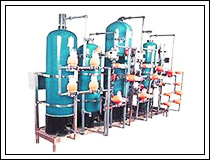Demineralization Plants
Natural water, during its course of flow, accumulates a lot of mineral salts and oligoelements that gets dissolved in it. Some of these minerals are important for  our health while some may tend to be extremely hazardous having adverse effects on human health. Most water treatment methods successfully clean and purify the water of its micro organisms but fail to stabilize these mineral salts. This is where demineralization plants come in handy as they efficiently treat water of these undesirable mineral salts leveraging on process like ion-exchange or chemical distillation. our health while some may tend to be extremely hazardous having adverse effects on human health. Most water treatment methods successfully clean and purify the water of its micro organisms but fail to stabilize these mineral salts. This is where demineralization plants come in handy as they efficiently treat water of these undesirable mineral salts leveraging on process like ion-exchange or chemical distillation.
The Process of Demineralization
Mineral salts when dissolves in water forms ions, both positive and negative which are collectively called electrolytes. Normally, all natural water has electrolytes in varying concentrations. The physical process of demineralization uses specially-manufactured ion exchange resins which bind to and filter out these mineral salts from water. The desired type of resin is held in an ion exchange vessel and water is passed through it. The selective ions in the water are exchanged with ions or radicals loosely held by the resin. In this way, the water is passed through several vessels or a mixed bed vessel so that both positive and negative ions are removed and water is demineralised.
Regeneration Techniques for DM Plants
Parallel Flow (co-current) Regeneration Technique
In this process, the exchange resin is loaded under down -stream conditions only.
Fixed Bed (counter-current) Counter Flow Process
The exchange resin in fixed bed counter flow process is loaded under down-stream and regenerated under up-stream conditions with dynamic back pressure that is created with water or air.
 Floating Bed/Counter Flow Process Floating Bed/Counter Flow Process
The regeneration is performed under down-stream flow, without hydraulic problems. The resin is loaded up-stream flow, so that the bed is kept floating.
Automatic Regeneration
This process is automatically controlled, and uses either of the following two systems to control the regeneration cycle:
- Relay based interlock and operation sequence logic
- PLC based interlock and operation sequence logic.
|